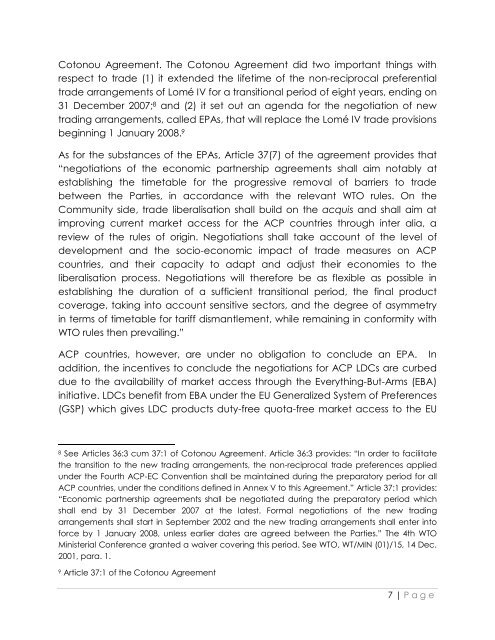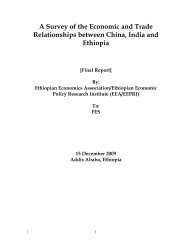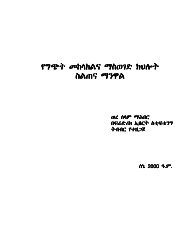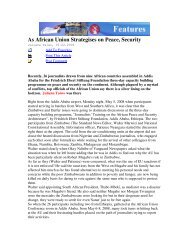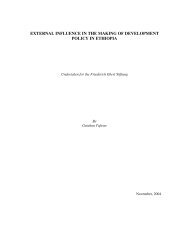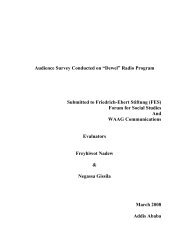Ethiopia and EPA Negotiation 2008 - FES Ethiopia
Ethiopia and EPA Negotiation 2008 - FES Ethiopia
Ethiopia and EPA Negotiation 2008 - FES Ethiopia
You also want an ePaper? Increase the reach of your titles
YUMPU automatically turns print PDFs into web optimized ePapers that Google loves.
Cotonou Agreement. The Cotonou Agreement did two important things with<br />
respect to trade (1) it extended the lifetime of the non-reciprocal preferential<br />
trade arrangements of Lomé IV for a transitional period of eight years, ending on<br />
31 December 2007; 8 <strong>and</strong> (2) it set out an agenda for the negotiation of new<br />
trading arrangements, called <strong>EPA</strong>s, that will replace the Lomé IV trade provisions<br />
beginning 1 January <strong>2008</strong>. 9<br />
As for the substances of the <strong>EPA</strong>s, Article 37(7) of the agreement provides that<br />
“negotiations of the economic partnership agreements shall aim notably at<br />
establishing the timetable for the progressive removal of barriers to trade<br />
between the Parties, in accordance with the relevant WTO rules. On the<br />
Community side, trade liberalisation shall build on the acquis <strong>and</strong> shall aim at<br />
improving current market access for the ACP countries through inter alia, a<br />
review of the rules of origin. <strong>Negotiation</strong>s shall take account of the level of<br />
development <strong>and</strong> the socio-economic impact of trade measures on ACP<br />
countries, <strong>and</strong> their capacity to adapt <strong>and</strong> adjust their economies to the<br />
liberalisation process. <strong>Negotiation</strong>s will therefore be as flexible as possible in<br />
establishing the duration of a sufficient transitional period, the final product<br />
coverage, taking into account sensitive sectors, <strong>and</strong> the degree of asymmetry<br />
in terms of timetable for tariff dismantlement, while remaining in conformity with<br />
WTO rules then prevailing.”<br />
ACP countries, however, are under no obligation to conclude an <strong>EPA</strong>. In<br />
addition, the incentives to conclude the negotiations for ACP LDCs are curbed<br />
due to the availability of market access through the Everything-But-Arms (EBA)<br />
initiative. LDCs benefit from EBA under the EU Generalized System of Preferences<br />
(GSP) which gives LDC products duty-free quota-free market access to the EU<br />
8 See Articles 36:3 cum 37:1 of Cotonou Agreement. Article 36:3 provides: “In order to facilitate<br />
the transition to the new trading arrangements, the non-reciprocal trade preferences applied<br />
under the Fourth ACP-EC Convention shall be maintained during the preparatory period for all<br />
ACP countries, under the conditions defined in Annex V to this Agreement.” Article 37:1 provides:<br />
“Economic partnership agreements shall be negotiated during the preparatory period which<br />
shall end by 31 December 2007 at the latest. Formal negotiations of the new trading<br />
arrangements shall start in September 2002 <strong>and</strong> the new trading arrangements shall enter into<br />
force by 1 January <strong>2008</strong>, unless earlier dates are agreed between the Parties.” The 4th WTO<br />
Ministerial Conference granted a waiver covering this period. See WTO, WT/MIN (01)/15, 14 Dec.<br />
2001, para. 1.<br />
9 Article 37:1 of the Cotonou Agreement<br />
7 | P a g e


